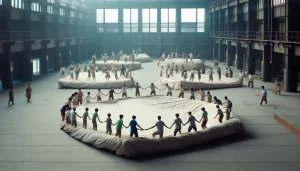
Going up or Going down
Item needed:
No items required

open

Min players:
4
Max players:
20
Required age:
12
Average cost:
$0
Game duration(Mins):
15 - 30
- Description
- How to play?
This team-building activity starts by splitting participants into pairs. Each pair stands back-to-back with hands raised and attempts to sit on the floor without falling. Once seated, they must stand back up, still with hands in the air. This exercise encourages teamwork and coordination. After successfully completing the task, teams are shuffled and expanded to groups of three, repeating the same sit-and-stand process. Following this, groups are further increased to four members, continuing the challenge. This versatile game is effective for groups of various sizes, ranging from four to twenty participants, making it an excellent icebreaker. It fosters collaboration, communication, and trust among participants, setting a positive tone for any group activity or event.
Game Manual: Going Up or Going Down
Game Overview
“Going Up or Going Down” is a fun and engaging team-building game that encourages cooperation, communication, and physical coordination. This versatile game is perfect as an icebreaker for groups ranging from small to medium size and is suitable for players aged 12 and up.
Objective
The primary goal is for teams to sit down and then stand back up without falling over, all while keeping their hands raised in the air. The game progresses by gradually increasing the team size to enhance the challenge and teamwork dynamics.
Players
- Minimum Players: 4
- Maximum Players: 20
- Minimum Age: 12 years old
How to Play
Setting Up
- Split into Teams:
- Start by dividing players into teams of two.
- Ensure that players within each team stand back-to-back.
1: Teams of Two
- Initial Position:
- Players stand back-to-back with their hands raised in the air.
- Sit Down:
- Without lowering their hands, participants must sit on the floor simultaneously, using each other for balance.
- Stand Up:
- Once seated, instruct the teams to stand back up without falling over and without lowering their hands.
- Successful Completion:
- Upon successfully standing up, the first round is complete.
2: Teams of Three
- Form New Teams:
- Mix up the participants to form new teams of three players each.
- Repeat the Process:
- Just like in Round 1, the teams of three should perform the sit-down and stand-up challenge with their hands in the air.
3: Teams of Four
- Form New Teams:
- Mix up the participants again to create teams of four players each.
- Repeat 0-=the Process:
- Repeat the sit-down and stand-up challenge with the larger teams.
Variations
- Larger Groups:
- If there are more players, continue increasing the team size beyond four to five or six players to add more complexity and fun.
- Smaller Groups:
- If playing with a smaller group (minimum four players), you can still vary the team sizes as long as there are at least two players per team.
End of the Game
- Continue the game until all participants have had the chance to play in various team sizes.
- The game can be stopped at any point based on the group’s engagement and enjoyment.
Tips for Success
- Communication: Encourage players to communicate effectively with their teammates to maintain balance.
- Pacing: Ensure that each round allows sufficient time for players to adjust and succeed in the challenge.
- Safety: Monitor the players to prevent any falls or injuries, especially when transitioning between sitting and standing.










